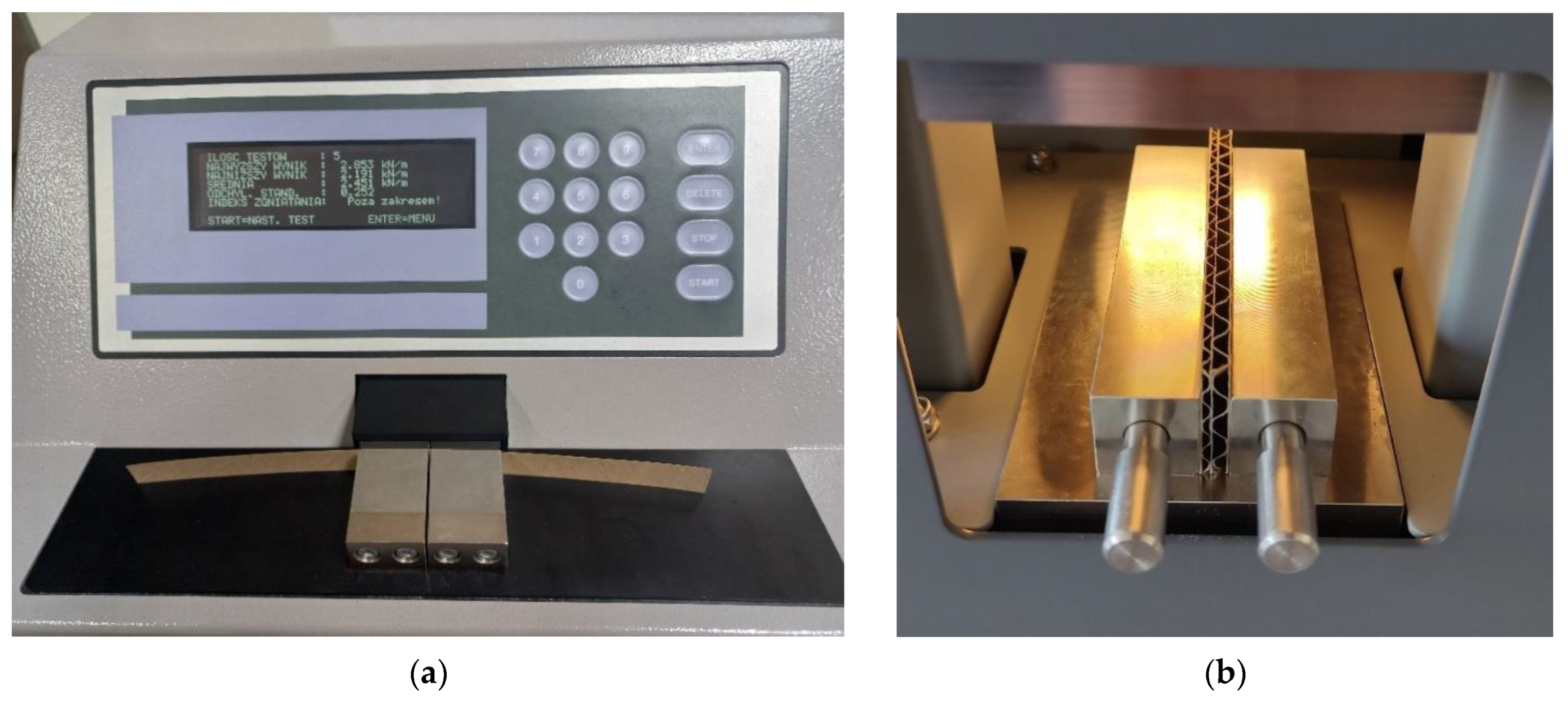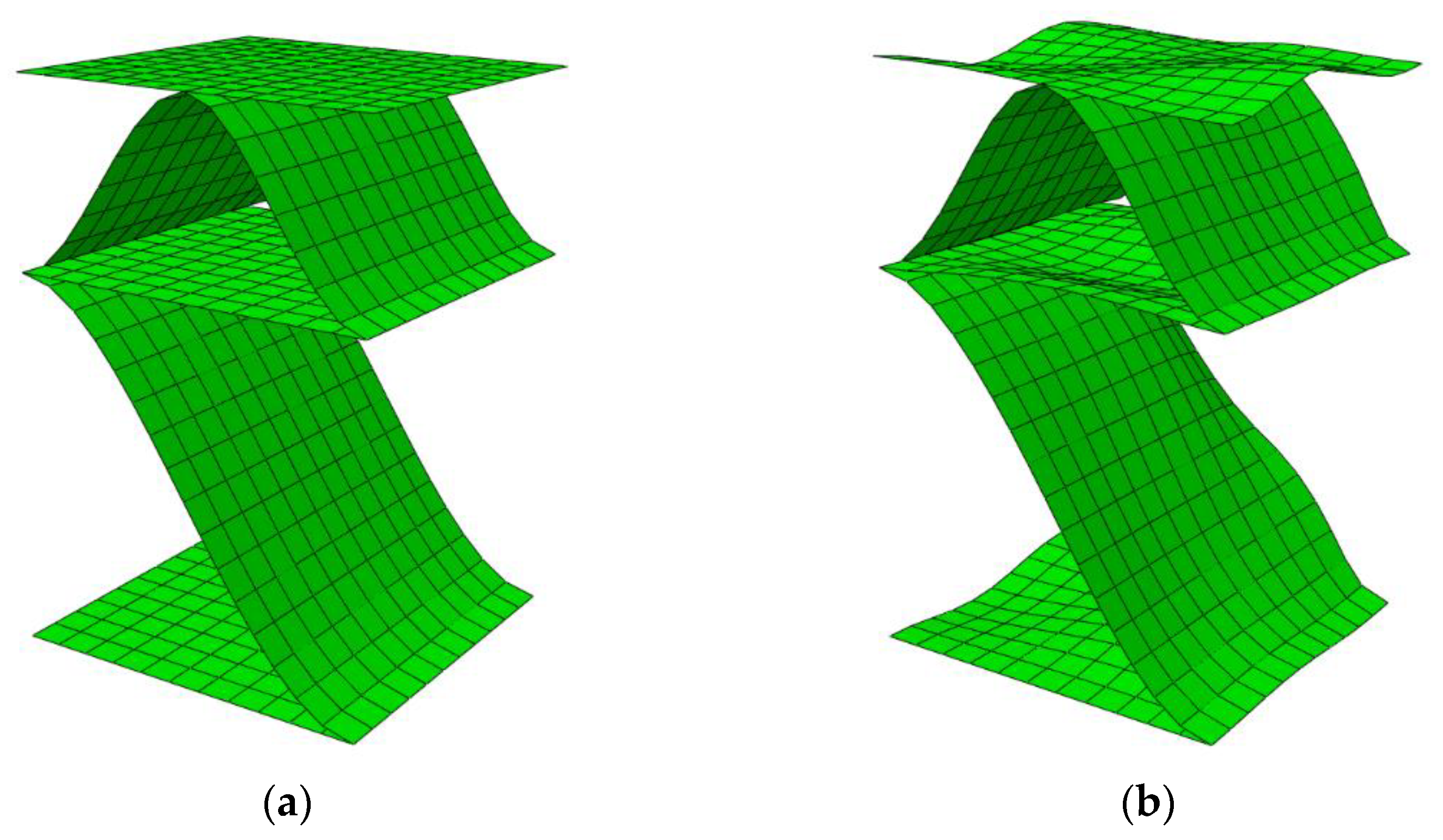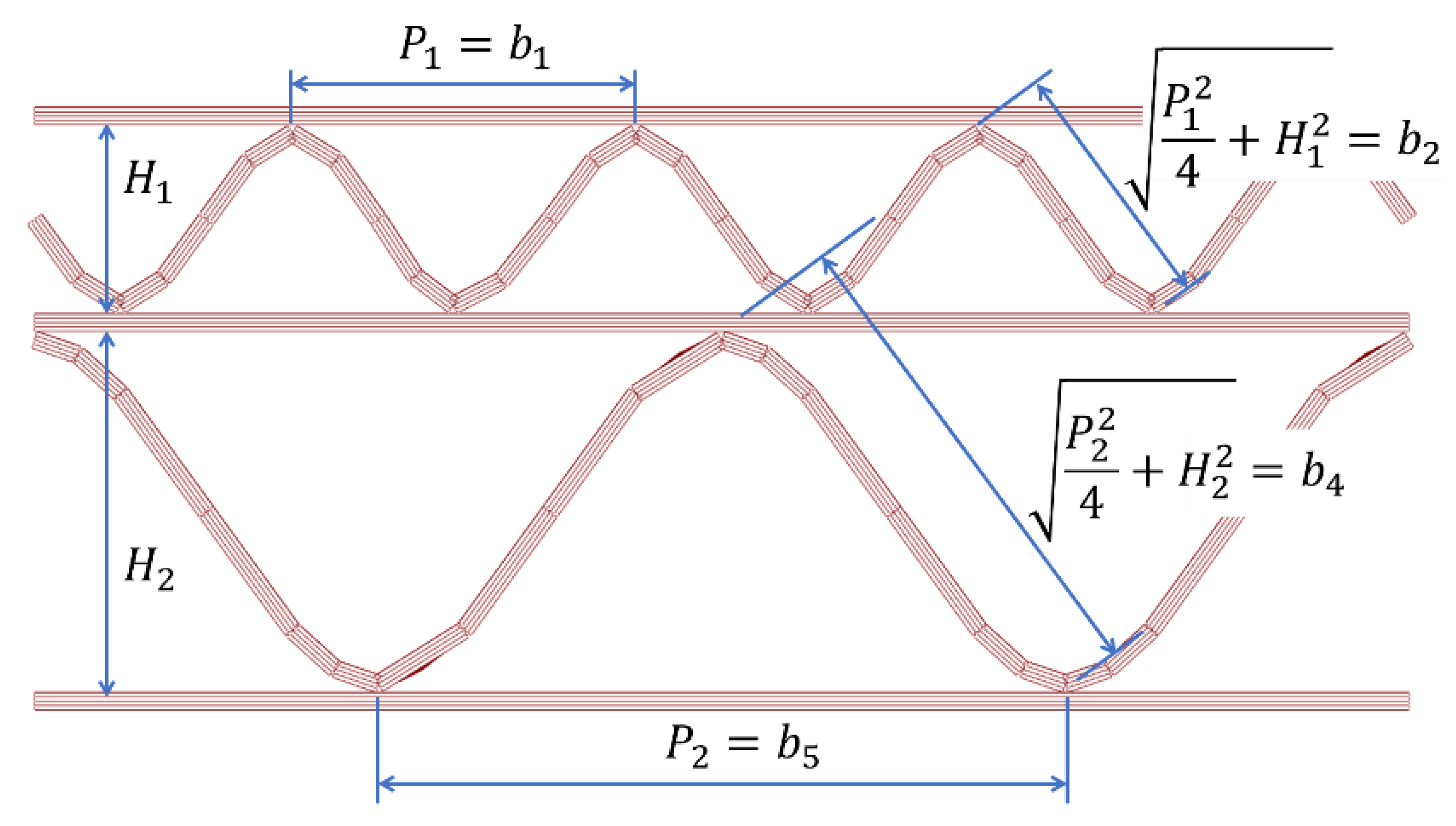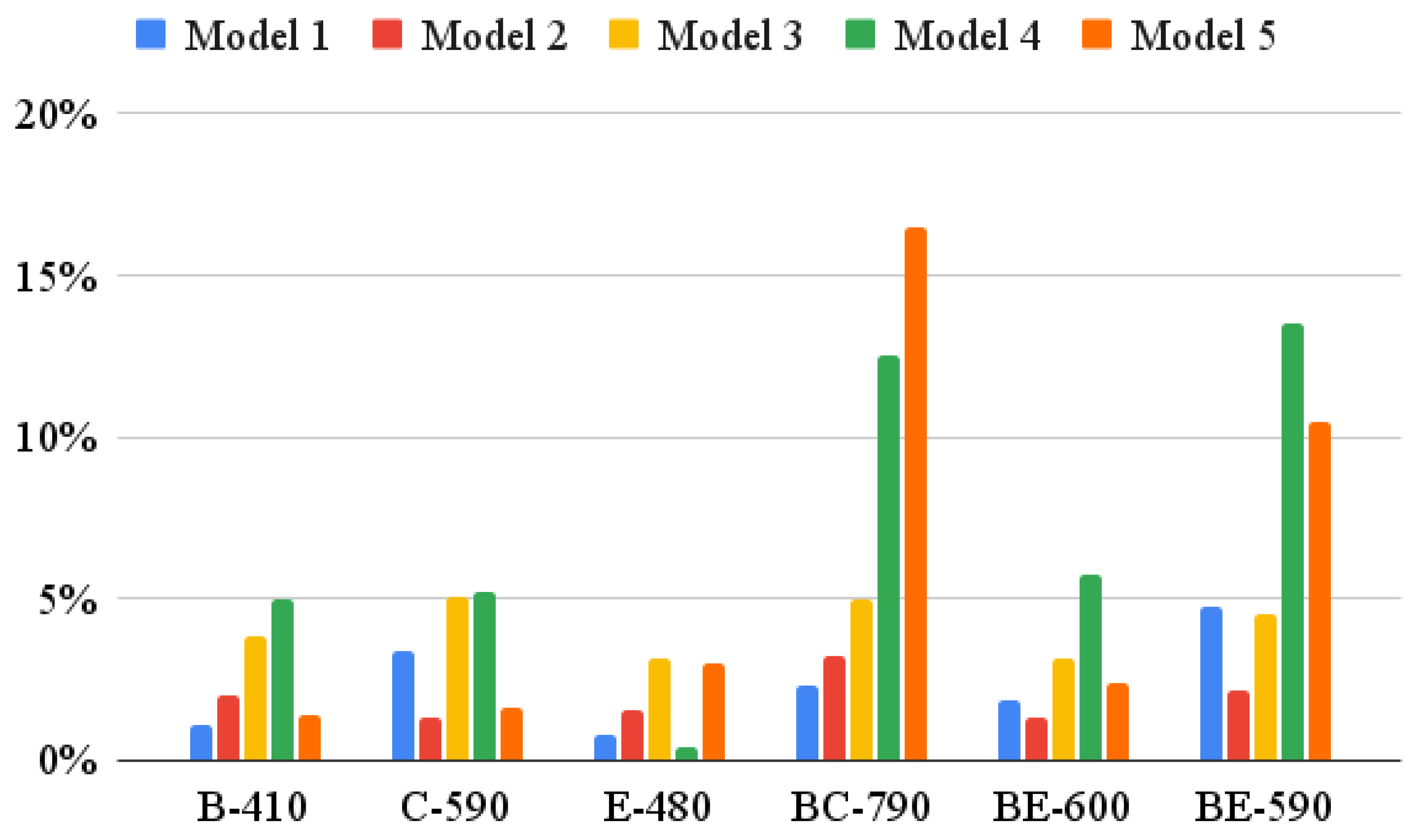Simplified Modelling of the Edge Crush Resistance of Multi-Layered Corrugated Board: Experimental and Computational Study
Abstract
1. Introduction
2. Materials and Methods
2.1. Laboratory Tests
2.2. Corrugated Board
2.3. Component Papers
2.4. Numerical Model
2.5. Empirical Model
2.6. Analytical-Empirical Model
3. Results
3.1. Laboratory Tests Results
3.2. The ECT Estimations by Numerical and Analytical-Empirical and Empirical Models
- Model 1: proposed analytical–empirical model, Equation (5);
- Model 2: numerical model FEM1 with imperfection 2%;
- Model 3: numerical model FEM2 with imperfection 9%;
- Model 4: empirical model described by Equation (4) with coefficient from Table 5 (column 3);
- Model 5: empirical model described by Equation (4) with coefficient from Table 5 (column 4).
4. Discussion
5. Conclusions
Author Contributions
Funding
Institutional Review Board Statement
Informed Consent Statement
Data Availability Statement
Acknowledgments
Conflicts of Interest
References
- Stott, R.A. Compression and stacking strength of corrugated fibreboard containers. Appita Technol. Innov. Manuf. Environ. 2017, 70, 76–82. [Google Scholar]
- Junli, W.; Quancheng, Z. Effect of moisture content of corrugated box on mechanical properties. J. Lanzhou Jiaotong Univ. 2006, 25, 134–136. [Google Scholar]
- Zhang, Y.-L.; Chen, J.; Wu, Y.; Sun, J. Analysis of hazard factors of the use of corrugated carton in packaging low-temperature yogurt during logistics. Procedia Environ. Sci. 2011, 10, 968–973. [Google Scholar] [CrossRef]
- Gallo, J.; Cortés, F.; Alberdi, E.; Goti, A. Mechanical behavior modeling of containers and octabins made of corrugated cardboard subjected to vertical stacking loads. Materials 2021, 14, 2392. [Google Scholar] [CrossRef]
- Whitsitt, W.J.; Gander, J.W.; McKee, R.C. Effect of Box Dimensions and Combined Board Creep Life on Box Creep Life; Institute of Paper Chemistry: Appleton, WI, USA, 1968. [Google Scholar]
- Urbanik, T.J.; Frank, B. Box compression analysis of world-wide data spanning 46 years. Wood Fiber Sci. 2006, 38, 399–416. [Google Scholar]
- Frank, B. Corrugated Box Compression—A Literature Survey. Packag. Technol. Sci. 2013, 27, 105–128. [Google Scholar] [CrossRef]
- Garbowski, T.; Gajewski, T.; Grabski, J.K. Estimation of the compressive strength of corrugated cardboard boxes with various perforations. Energies 2021, 14, 1095. [Google Scholar] [CrossRef]
- Garbowski, T.; Gajewski, T.; Grabski, J.K. Estimation of the compressive strength of corrugated cardboard boxes with various openings. Energies 2021, 14, 155. [Google Scholar] [CrossRef]
- Mrówczyński, D.; Garbowski, T.; Knitter-Piątkowska, A. Estimation of the compressive strength of corrugated cardboard boxes with shifted creases on the flaps. Materials 2021, 14, 5181. [Google Scholar] [CrossRef]
- McKee, R.C.; Gander, J.W.; Wachuta, J.R. Compression strength formula for corrugated boxes. Paperboard Packag. 1963, 48, 149–159. [Google Scholar]
- TAPPI T 839 om-12; Edge Compression Test for Strength of Corrugated Fiberboard Using the Clamp Method (Short Column Test). TAPPI: Peachtree Corners, GA, USA, 2009.
- TAPPI T 838 cm-12; Edge Crush Test Using Neckdown. TAPPI: Peachtree Corners, GA, USA, 2009.
- FEFCO NO.8; Edgewise Crush Resistance of Corrugated Fiberboard. FEFCO: Brussels, Belgium, 1997.
- ISO 3037:2013; Corrugated Fibreboard—Determination of Edgewise Crush Resistance (Unwaxed Edge Method). ISO: Geneva, Switzerland, 2013.
- TAPPI T 811 om-11; Edgewise Compressive Strength of Corrugated Fibreboard (Short Column Test). TAPPI: Peachtree Corners, GA, USA, 2009.
- ISO 13821:2002; Corrugated Fibreboard—Determination of Edgewise Crush Resistance—Waxed Edge Method. ISO: Geneva, Switzerland, 2002.
- Garbowski, T.; Niziałek-Łukawska, M.; Kuca, M. Analytical verification of popular McKee’s formula. Pol. Pap. Rev. 2019, 75, 767–773. (In Polish) [Google Scholar]
- Maltenfort, G. Compression strength of corrugated containers. Fibre Contain. 1956, 41, 106–121. [Google Scholar]
- Allerby, I.M.; Laing, G.N.; Cardwell, R.D. Compressive strength—From components to corrugated containers. Appita Conf. Notes 1985, 1–11. [Google Scholar]
- Schrampfer, K.E.; Whitsitt, W.J.; Baum, G.A. Combined Board Edge Crush (ECT) Technology; Institute of Paper Chemistry: Appleton, WI, USA, 1987. [Google Scholar]
- Kawanishi, K. Estimation of the compression strength of corrugated fibreboard boxes and its application to box design using a personal computer. Packag. Technol. Sci. 1989, 2, 29–39. [Google Scholar] [CrossRef]
- Batelka, J.J.; Smith, C.N. Package Compression Model; Institute of Paper Science and Technology, Georgia Institute of Technology: Atlanta, GA, USA, 1993. [Google Scholar]
- Mrówczyński, D.; Knitter-Piątkowska, A.; Garbowski, T. Non-Local Sensitivity Analysis and Numerical Homogenization in Optimal Design of Single-Wall Corrugated Board Packaging. Materials 2022, 15, 720. [Google Scholar] [CrossRef] [PubMed]
- Mrówczyński, D.; Knitter-Piątkowska, A.; Garbowski, T. Optimal Design of Double-Walled Corrugated Board Packaging. Materials 2022, 15, 2149. [Google Scholar] [CrossRef] [PubMed]
- Garbowski, T.; Knitter-Piątkowska, A. Analytical determination of the bending stiffness of a five-layer corrugated cardboard with imperfections. Materials 2022, 15, 663. [Google Scholar] [CrossRef]
- Czechowski, L.; Kmita-Fudalej, G.; Szewczyk, W.; Gralewski, J.; Bieńkowska, M. Numerical and experimental study of five-layer non-symmetrical paperboard panel stiffness. Materials 2021, 14, 7453. [Google Scholar] [CrossRef]
- Zienkiewicz, O.C.; Taylor, R.L.; Zhu, J.Z. The Finite Element Method: Its Basis and Fundamentals, 1st ed.; Butterworth-Heinemann: Oxford, UK, 2013. [Google Scholar]
- De Borst, R.; Crisfield, M.A.; Remmers, J.J.C.; Verhoosel, C.V. Nonlinear Finite Element Analysis of Solids and Structures, 2nd ed.; Wiley: Chichester, UK, 2012. [Google Scholar]
- Fadiji, T.; Coetzee, C.J.; Berry, T.M.; Ambaw, A.; Opara, U.L. The efficacy of finite element analysis (FEA) as a design tool for food packaging: A review. Biosyst. Eng. 2018, 174, 20–40. [Google Scholar] [CrossRef]
- Domaneschi, M.; Perego, U.; Borgqvist, E.; Borsari, R. An industry-oriented strategy for the finite element simulation of paperboard creasing and folding. Packag. Technol. Sci. 2017, 30, 269–294. [Google Scholar] [CrossRef]
- Awais, M.; Tanninen, P.; Leppänen, T.; Matthews, S.; Sorvari, J.; Varis, J.; Backfol, K. A computational and experimental analysis of crease behavior in press forming process. Procedia Manuf. 2018, 17, 835–842. [Google Scholar] [CrossRef]
- Thakkar, B.K.; Gooren, L.G.J.; Peerlings, R.H.J.; Geers, M.G.D. Experimental and numerical investigation of creasing in corrugated paperboard. Philos. Mag. 2008, 88, 3299–3310. [Google Scholar] [CrossRef][Green Version]
- Beex, L.A.A.; Peerlings, R.H.J. An experimental and computational study of laminated paperboard creasing and folding. Int. J. Solids Struct. 2009, 46, 4192–4207. [Google Scholar] [CrossRef]
- Giampieri, A.; Perego, U.; Borsari, R. A constitutive model for the mechanical response of the folding of creased paperboard. Int. J. Solids Struct. 2011, 48, 2275–2287. [Google Scholar] [CrossRef]
- Leminen, V.; Tanninen, P.; Pesonen, A.; Varis, J. Effect of mechanical perforation on the press-forming process of paperboard. Procedia Manuf. 2019, 38, 1402–1408. [Google Scholar] [CrossRef]
- Garbowski, T.; Jarmuszczak, M. Numerical strength estimate of corrugated board packages. Part 1. Theoretical assumptions in numerical modeling of paperboard packages. Pol. Pap. Rev. 2014, 70, 219–222. (In Polish) [Google Scholar]
- Garbowski, T.; Jarmuszczak, M. Numerical strength estimate of corrugated board packages. Part 2. Experimental tests and numerical analysis of paperboard packages. Pol. Pap. Rev. 2014, 70, 277–281. (In Polish) [Google Scholar]
- Park, J.; Chang, S.; Jung, H.M. Numerical prediction of equivalent mechanical properties of corrugated paperboard by 3D finite element analysis. Appl. Sci. 2020, 10, 7973. [Google Scholar] [CrossRef]
- Park, J.; Park, M.; Choi, D.S.; Jung, H.M.; Hwang, S.W. Finite element-based simulation for edgewise compression behavior of corrugated paperboard for packing of agricultural products. Appl. Sci. 2020, 10, 6716. [Google Scholar] [CrossRef]
- Nordstrand, T.; Carlsson, L. Evaluation of transverse shear stiffness of structural core sandwich plates. Compos. Struct. 1997, 37, 145–153. [Google Scholar] [CrossRef]
- Słonina, M.; Dziurka, D.; Smardzewski, J. Experimental research and numerical analysis of the elastic properties of paper cell cores before and after impregnation. Materials 2020, 13, 2058. [Google Scholar] [CrossRef] [PubMed]
- Jamsari, M.A.; Kueh, C.; Gray-Stuart, E.M.; Dahm, K.; Bronlund, J.E. Experimental and numerical performance of corrugated fibreboard at different orientations under four-point bending test. Packag. Technol. Sci. 2019, 32, 555–565. [Google Scholar] [CrossRef]
- Urbanik, T.J.; Saliklis, E.P. Finite element corroboration of buckling phenomena observed in corrugated boxes. Wood Fiber Sci. 2003, 35, 322–333. [Google Scholar]
- Allaoui, S.; Benzeggagh, M.L.; Aboura, Z.; Talbi, N. Elastic behaviour of corrugated cardboard: Experiments and modeling. Compos. Struct. 2004, 63, 53–62. [Google Scholar]
- Biancolini, M.E. Evaluation of equivalent stiffness properties of corrugated board. Compos. Struct. 2005, 69, 322–328. [Google Scholar] [CrossRef]
- Garbowski, T.; Jarmuszczak, M. Homogenization of corrugated paperboard. Part 1. Analytical homogenization. Pol. Pap. Rev. 2014, 70, 345–349. (In Polish) [Google Scholar]
- Garbowski, T.; Jarmuszczak, M. Homogenization of corrugated paperboard. Part 2. Numerical homogenization. Pol. Pap. Rev. 2014, 70, 390–394. (In Polish) [Google Scholar]
- Garbowski, T.; Gajewski, T. Determination of transverse shear stiffness of sandwich panels with a corrugated core by numerical homogenization. Materials 2021, 14, 1976. [Google Scholar] [CrossRef]
- Garbowski, T.; Knitter-Piątkowska, A.; Mrówczyński, D. Numerical homogenization of multi-layered corrugated cardboard with creasing or perforation. Materials 2021, 14, 3786. [Google Scholar] [CrossRef]
- Mrówczyński, D.; Knitter-Piątkowska, A.; Garbowski, T. Numerical Homogenization of Single-Walled Corrugated Board with Imperfections. Appl. Sci. 2022, 12, 9632. [Google Scholar] [CrossRef]
- Ramírez-Torres, A.; Penta, R.; Rodríguez-Ramos, R.; Merodio, J.; Sabina, F.J.; Bravo-Castillero, J.; Guinovart-Díaz, R.; Preziosi, L.; Grillo, A. Three scales asymptotic homogenization and its application to layered hierarchical hard tissues. Int. J. Solids Struct. 2018, 130–131, 190–198. [Google Scholar] [CrossRef]
- Ramírez-Torres, A.; Di Stefano, S.; Grillo, A.; Rodríguez-Ramos, R.; Merodio, J.; Penta, R. An asymptotic homogenization approach to the microstructural evolution of heterogeneous media. Int. J. Non-Linear Mech. 2018, 106, 245–257. [Google Scholar] [CrossRef]
- Hohe, J. A direct homogenization approach for determination of the stiffness matrix for microheterogeneous plates with application to sandwich panels. Compos. Part B Eng. 2003, 34, 615–626. [Google Scholar] [CrossRef]
- Buannic, N.; Cartraud, P.; Quesnel, T. Homogenization of corrugated core sandwich panels. Compos. Struct. 2003, 59, 299–312. [Google Scholar] [CrossRef]
- Abbès, B.; Guo, Y.Q. Analytic homogenization for torsion of orthotropic sandwich plates. Compos. Struct. 2010, 92, 699–706. [Google Scholar] [CrossRef]
- Marin, G.; Srinivasa, P.; Nygårds, M.; Östlund, S. Experimental and finite element simulated box compression tests on paperboard packages at different moisture levels. Packag. Technol. Sci. 2021, 34, 229–243. [Google Scholar] [CrossRef]
- Suarez, B.; Muneta, M.L.M.; Sanz-Bobi, J.D.; Romero, G. Application of homogenization approaches to the numerical analysis of seating made of multi-wall corrugated cardboard. Compos. Struct. 2021, 262, 113642. [Google Scholar] [CrossRef]
- FEMat BSE Systems. Available online: http://fematsystems.pl/bse-system_en (accessed on 17 October 2022).
- Garbowski, T.; Grabski, J.K.; Marek, A. Full-field measurements in the edge crush test of a corrugated board—Analytical and numerical predictive models. Materials 2021, 14, 2840. [Google Scholar] [CrossRef]
- Garbowski, T.; Knitter-Piątkowska, A.; Marek, A. New edge crush test configuration enhanced with full-field strain measurements. Materials 2021, 14, 5768. [Google Scholar] [CrossRef]
- Hägglund, R.; Åslund, P.E.; Carlsson, L.A.; Isaksson, P. Measuring thickness changes of edgewise compression loaded corrugated board panels using digital image correlation. J. Sandw. Struct. Mater. 2010, 14, 75–94. [Google Scholar] [CrossRef]
- Viguié, J.; Dumont, P.J.J. Analytical post-buckling model of corrugated board panels using digital image correlation measurements. Comp. Struct. 2013, 101, 243–254. [Google Scholar] [CrossRef]
- Fadiji, T.; Coetzee, C.J.; Opara, U.L. Evaluating the displacement field of paperboard packages subjected to compression loading using digital image correlation (DIC). Food Bioprod. Process. 2020, 123, 60–71. [Google Scholar] [CrossRef]
- Maier, G.; Bolzon, G.; Buljak, V.; Garbowski, T.; Miller, B. Synergic combinations of computational methods and experiments for structural diagnoses. In Computer Methods in Mechanics; Kuczma, M., Wilmanski, K., Eds.; Advanced Structured Materials; Springer: Berlin/Heidelberg, Germany, 2010; Volume 1, pp. 453–476. [Google Scholar]
- Garbowski, T.; Imbierowicz, R. Sensitivity analysis of edge crush test. Przegląd Pap. 2014, 70, 559–564. (In Polish) [Google Scholar]
- Dimitrov, K.; Heydenrych, M. Relationship between the edgewise compression strength of corrugated board and the compression strength of liner and fluting medium papers. South. For. 2009, 71, 227–233. [Google Scholar] [CrossRef]
- Popil, R.E. Overview of recent studies at IPST on corrugated board edge compression strength: Testing methods and effects of interflute buckling. BioResources 2012, 7, 2553–2581. [Google Scholar] [CrossRef][Green Version]
- Frank, B. Revisiting clamped ECT. Corrugat. Int. 2007, Summer, 7–11. [Google Scholar]
- Popil, R.E.; Hojjatie, B. Effects of component properties and orientation on corrugated container endurance. Packag. Technol. Sci. 2010, 23, 189–202. [Google Scholar] [CrossRef]
- Wilson, C.J.; Frank, B. An evaluation of ECT sample height for small flute board grades and Box Manufacturer’s Certification compliance. Tappi J. 2009, 8, 24–28. [Google Scholar] [CrossRef]
- Frank, B.; Cash, D. Edge crush testing methods and box compression modeling. Tappi J. 2022, 21, 418. [Google Scholar] [CrossRef]
- ISO 9073-3:1989; Textiles—Test methods for nonwovens—Part 3: Determination of tensile strength and elongation. ISO: Geneva, Switzerland, 1989.
- ISO 9895:2008; Paper and board—Compressive strength—Short-span test. ISO: Geneva, Switzerland, 2008.
- Patel, P.; Nordstrand, T.; Carlsson, L.A. Local buckling and collapse of corrugated board under biaxial stress. Compos. Struct. 1997, 39, 93–110. [Google Scholar] [CrossRef]
- Nyman, U.; Gustafsson, P.J. Material and structural failure criterion of corrugated board facings. Compos. Struct. 2000, 50, 79–83. [Google Scholar] [CrossRef]
- Daxner, T.; Flatscher, T.; Rammerstorfer, F.G. Optimum Design of Corrugated Board under Buckling Constraints. In Proceedings of the 7th World Congress on Structural and Multidisciplinary Optimization, Seoul, Korea, 21–25 May 2007; pp. 349–358. [Google Scholar]
- Ma, Y.; Gong, Z.; Liang Zhao, L.; Han, Y.; Wang, Y. Finite Element Analysis of Buckling of Corrugated Fiberboard. Open Mech. Eng. J. 2014, 8, 257–263. [Google Scholar] [CrossRef][Green Version]






| Wave | Grammage | Component | Height | Period | Take-Up |
|---|---|---|---|---|---|
| Type | (g/m2) | Papers | (mm) | (mm) | Factor |
| B | 410 | TL3125/WS120/TL3125 | 2.55 | 6.34 | 1.337 |
| C | 590 | KLB170/S.C.175/KLB170 | 3.63 | 7.95 | 1.427 |
| E | 480 | TLWC160/WS 135/TLW160 | 1.16 | 3.50 | 1.236 |
| BC | 790 | KLB170/WS135/WS80/WS135/KLB170 | - | - | - |
| BE | 600 | TLW140/WS95/WS80/WS95/TL3125 | - | - | - |
| BE | 590 | TL3125/WS95/WS80/WS95/TL3125 | - | - | - |
| Wave Type | Grammage (g/m2) | Cardboard ID | Height (mm) |
|---|---|---|---|
| B | 410 | B-410 | 2.912 |
| C | 590 | C-590 | 4.110 |
| E | 480 | E-480 | 1.586 |
| BC | 790 | BC-790 | 6.740 |
| BE | 600 | BE-600 | 4.150 |
| BE | 590 | BE-590 | 4.120 |
| Cardboard ID | Type of Paper | Grammage (g/m2) | Layer |
|---|---|---|---|
| B-410 | TL3 | 125 | Liner ext. |
| WS | 120 | Fluting | |
| TL3 | 125 | Liner intern. | |
| C-590 | KLB | 170 | Liner ext. |
| S.C. | 175 | Fluting | |
| KLB | 170 | Liner intern. | |
| E-480 | TLWC | 160 | Liner ext. |
| WS | 135 | Fluting | |
| TLW | 160 | Liner intern. | |
| BC-790 | KLB | 170 | Liner ext. |
| WS | 135 | Fluting (B) | |
| WS | 80 | Liner | |
| WS | 135 | Fluting (C) | |
| KLB | 170 | Liner intern. | |
| BE-600 | TLW | 140 | Liner ext. |
| WB | 95 | Fluting (E) | |
| WB | 80 | Liner | |
| WB | 95 | Fluting (B) | |
| TL3 | 125 | Liner intern. | |
| BE-590 | TL3 | 125 | Liner ext. |
| WS | 95 | Fluting (E) | |
| WS | 80 | Liner | |
| WS | 95 | Fluting (B) | |
| TL3 | 125 | Liner intern. |
| Cardboard ID | Paper ID | SCT-CD (N/mm) | TS-CD (N/mm) | TS-MD (N/mm) | TS-45 (N/mm) |
|---|---|---|---|---|---|
| B-410 | TL3-125 | 2.14 | 373.33 | 1012.7 | 572.68 |
| WS-120 | 2.09 | 365.06 | 1024.6 | 516.50 | |
| TL3-125 | 2.09 | 381.15 | 1058.3 | 595.08 | |
| C-590 | KLB-170 | 3.28 | 527.77 | 1472.1 | 929.12 |
| SC-175 | 4.18 | 686.08 | 1476.1 | 924.73 | |
| KLB-170 | 3.19 | 568.05 | 1445.1 | 956.22 | |
| E-480 | TLWC-160 | 2.75 | 412.14 | 1043.6 | 635.01 |
| WS-135 | 2.13 | 365.02 | 1067.5 | 533.52 | |
| TLW-160 | 2.43 | 443.86 | 1102.1 | 667.03 | |
| BC-790 | KLB-170 | 3.39 | 618.88 | 1534.2 | 990.02 |
| WS-135 | 2.19 | 369.08 | 1113.5 | 572.41 | |
| WS-80 | 1.50 | 317.09 | 699.14 | 445.02 | |
| WS-135 | 2.23 | 385.91 | 1147.4 | 623.54 | |
| KLB-170 | 3.30 | 592.74 | 1418.9 | 838.15 | |
| BE-600 | TLW-140 | 2.61 | 505.95 | 999.95 | 622.60 |
| WS-95 | 1.69 | 331.94 | 872.70 | 498.63 | |
| WS-80 | 1.42 | 273.16 | 812.83 | 424.82 | |
| WS-95 | 1.52 | 290.66 | 885.54 | 508.44 | |
| TL3-125 | 2.13 | 440.63 | 1082.2 | 623.26 | |
| BE-590 | TL3-120 | 2.26 | 412.94 | 961.28 | 586.98 |
| WS-95 | 1.50 | 294.34 | 756.40 | 427.40 | |
| WS-80 | 1.47 | 343.54 | 696.51 | 459.84 | |
| WS-95 | 1.75 | 332.01 | 854.73 | 474.40 | |
| TL3-125 | 2.32 | 413.77 | 883.13 | 588.29 |
| Cardboard ID | Equation (4) | Equation (6) | Equation (7) | ||
|---|---|---|---|---|---|
| (1) | (2) | (3) | (4) | (5) | (6) |
| B-410 | 0.781 | 0.791 | 0.819 | 52 | - |
| C-590 | 0.778 | ||||
| E-480 | 0.815 | ||||
| BC-790 | 0.728 | 0.848 | 0.819 | - | 18 |
| BE-600 | 0.869 | ||||
| BE-590 | 0.947 | ||||
| Cardboard ID | ECT (ref) (N/mm) | ECT (M1) (N/mm) | ECT (M2) (N/mm) | ECT (M3) (N/mm) |
|---|---|---|---|---|
| B-410 | 5.48 | 5.54 | 5.59 | 5.27 |
| C-590 | 9.68 | 9.35 | 9.81 | 9.19 |
| E-480 | 6.37 | 6.32 | 6.47 | 6.17 |
| BC-790 | 10.41 | 10.65 | 10.75 | 9.89 |
| BE-600 | 8.95 | 9.12 | 9.07 | 8.67 |
| BE-590 | 9.68 | 9.22 | 9.89 | 9.24 |
| Cardboard ID | Error (M1) (%) | Error (M2) (%) | Error (M3) (%) | Error (M4) (%) | Error (M5) (%) |
|---|---|---|---|---|---|
| B-410 | 1.09 | 2.01 | −3.83 | 4.98 | 1.39 |
| C-590 | −3.41 | 1.34 | −5.06 | 5.21 | 1.61 |
| E-480 | −0.78 | 1.57 | −3.14 | 0.45 | −2.99 |
| BC-790 | 2.31 | 3.27 | −5.00 | 12.51 | 16,49 |
| BE-600 | 1.90 | 1.34 | −3.13 | −5.76 | −2.43 |
| BE-590 | −4.75 | 2.17 | −4.55 | −13.54 | −10.48 |
Disclaimer/Publisher’s Note: The statements, opinions and data contained in all publications are solely those of the individual author(s) and contributor(s) and not of MDPI and/or the editor(s). MDPI and/or the editor(s) disclaim responsibility for any injury to people or property resulting from any ideas, methods, instructions or products referred to in the content. |
© 2023 by the authors. Licensee MDPI, Basel, Switzerland. This article is an open access article distributed under the terms and conditions of the Creative Commons Attribution (CC BY) license (https://creativecommons.org/licenses/by/4.0/).
Share and Cite
Garbowski, T.; Knitter-Piątkowska, A.; Winiarski, P. Simplified Modelling of the Edge Crush Resistance of Multi-Layered Corrugated Board: Experimental and Computational Study. Materials 2023, 16, 458. https://doi.org/10.3390/ma16010458
Garbowski T, Knitter-Piątkowska A, Winiarski P. Simplified Modelling of the Edge Crush Resistance of Multi-Layered Corrugated Board: Experimental and Computational Study. Materials. 2023; 16(1):458. https://doi.org/10.3390/ma16010458
Chicago/Turabian StyleGarbowski, Tomasz, Anna Knitter-Piątkowska, and Piotr Winiarski. 2023. "Simplified Modelling of the Edge Crush Resistance of Multi-Layered Corrugated Board: Experimental and Computational Study" Materials 16, no. 1: 458. https://doi.org/10.3390/ma16010458
APA StyleGarbowski, T., Knitter-Piątkowska, A., & Winiarski, P. (2023). Simplified Modelling of the Edge Crush Resistance of Multi-Layered Corrugated Board: Experimental and Computational Study. Materials, 16(1), 458. https://doi.org/10.3390/ma16010458








